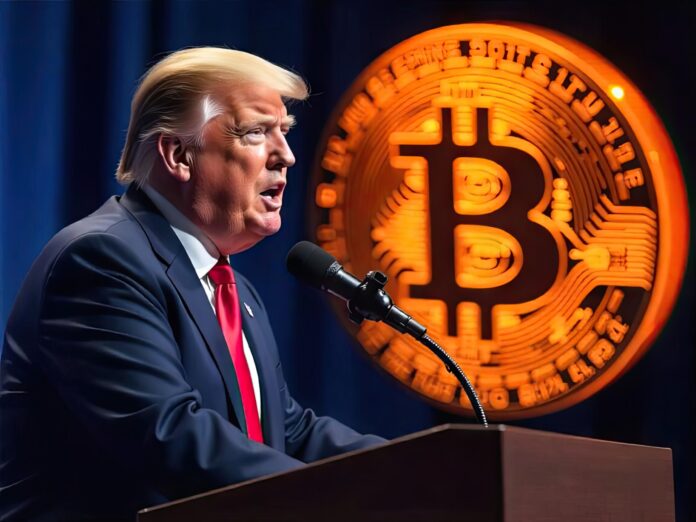In a remarkable transformation that mirrors the volatile nature of the cryptocurrency market itself, President Donald Trump has evolved from calling Bitcoin “a scam” just a few years ago to becoming one of its most powerful advocates. On March 6, 2025, Trump signed an executive order establishing the Strategic Bitcoin Reserve and U.S. Digital Asset Stockpile, a move that sent shockwaves through the crypto ecosystem and financial markets worldwide.
The plan, which designates approximately 200,000 Bitcoin (worth around $17 billion) seized through government forfeiture proceedings as a national reserve asset, represents a dramatic shift in the U.S. government’s approach to digital currencies. No longer viewed merely as speculative assets or tools for illicit activities, cryptocurrencies—particularly Bitcoin—are now being positioned as strategic national resources worthy of preservation in the government’s financial arsenal.
This seismic policy shift is creating significant ripples across the crypto market, with both immediate impacts and long-term implications for investors, institutions, and the global financial system. As the United States takes this unprecedented step toward embracing digital assets at the governmental level, market participants are scrambling to understand what it means for the future of cryptocurrency adoption, regulation, and valuation.
This article explores how Trump’s Strategic Reserve Plan is reshaping the crypto landscape, examining the immediate market reactions, expert perspectives, and potential long-term consequences of this bold initiative that aims to position America as the “crypto capital of the world.”
Understanding Trump’s Strategic Reserve Plan
From Crypto Skeptic to Champion
President Trump’s journey with cryptocurrency has been anything but straightforward. In 2021, he famously dismissed Bitcoin as “a scam against the dollar” and suggested its value was “based on thin air.” His administration, particularly through the Securities and Exchange Commission, took a largely adversarial approach to the crypto industry.
However, during his 2024 presidential campaign, Trump’s stance underwent a dramatic reversal. This shift coincided with significant fundraising from crypto industry leaders, including a reported $25 million raised at a Bitcoin conference in July 2024. By the time of his inauguration in January 2025, Trump had fully embraced cryptocurrency, promising to make the United States the “crypto capital of the planet” and floating the idea of a strategic reserve.
Key Components of the Executive Order
The executive order signed on March 6, 2025, establishes two distinct entities:
- The Strategic Bitcoin Reserve: This reserve will be capitalized with Bitcoin owned by the Department of Treasury that was forfeited as part of criminal or civil asset forfeiture proceedings. According to White House “crypto czar” David Sacks, the U.S. government currently holds approximately 200,000 Bitcoin (worth about $17 billion). The order explicitly states that “the United States will not sell bitcoin deposited into this Strategic Bitcoin Reserve,” treating it as a store of reserve assets.
- The U.S. Digital Asset Stockpile: This separate stockpile will consist of digital assets other than Bitcoin owned by the Department of Treasury through forfeiture proceedings. Unlike the Bitcoin Reserve, the government may determine strategies for the “responsible stewardship” of these assets, including potential sales.
The order also authorizes the Secretaries of Treasury and Commerce to “develop budget-neutral strategies for acquiring additional bitcoin,” though it specifies that these strategies must “impose no incremental costs on American taxpayers.” This provision has sparked debate about what “budget-neutral” acquisition might entail.
Official Rationale and Political Context
The White House has framed the Strategic Reserve as addressing a “crypto management gap” in government policy. The fact sheet accompanying the executive order highlights several justifications:
- Bitcoin is referred to as “digital gold” because of its scarcity and security
- With a fixed supply of 21 million coins, there is a strategic advantage to being among the first nations to create a Strategic Bitcoin Reserve
- Premature sales of Bitcoin have already cost U.S. taxpayers over $17 billion in potential value
- The current disjointed handling of cryptocurrencies seized through forfeiture has led to a lack of accountability
Beyond these practical considerations, the move fulfills a campaign promise and signals the administration’s commitment to the crypto industry. Trump appointed a dedicated “crypto czar” and hosted the first-ever crypto summit at the White House, demonstrating the political importance attached to this initiative.
The Current State of the Crypto Market
Market Performance in 2025
The cryptocurrency market entered 2025 with significant momentum following Trump’s election victory. Bitcoin reached its all-time high of $108,786 on January 20, 2025—the day of Trump’s inauguration—reflecting optimism about his anticipated crypto-friendly policies.
However, the first quarter of 2025 proved challenging for the cryptocurrency market. According to Nasdaq’s Q1 2025 review, Bitcoin suffered its worst first quarter performance in seven years, falling 11.82% for the period. Ethereum fared even worse, dropping 45.41%. By the end of March, Bitcoin was trading around $80,000, while Ethereum struggled to retake the $2,000 threshold after dipping below it mid-month.
More recently, Bitcoin experienced further volatility, dropping to $74,000 in early April before rebounding slightly to around $78,000. This represents a 28% decline from January’s peak and a 16% drop for 2025 overall. Other major cryptocurrencies have shown similar patterns of volatility, with some performing even worse than Bitcoin.

Key Market Trends
Despite price volatility, several important trends have emerged in the crypto market:
- Institutional Involvement: A defining feature of 2025 has been the continued and increasing involvement of institutional players. Companies like MicroStrategy and BlackRock have accumulated substantial portions of Bitcoin’s supply in Q1. Major banks, including BNY Mellon, have incorporated cryptocurrency services to allow transactions between certain clients using Circle’s USDC.
- Stablecoin Growth: The total market cap for stablecoins surged past $200 billion in Q1, outpacing Bitcoin’s price trajectory for the period. USDC notably outpaced USDT in growth, expanding its market share from 20% to 25.7%.
- Regulatory Progress: Lawmakers have focused on passing stablecoin legislation, specifically Senator Bill Hagerty’s GENIUS Act, which is currently awaiting a full House vote. The Office of the Comptroller of the Currency (OCC) issued guidance permitting banks to custody cryptocurrencies, while the IRS’s DeFi Broker Rule was overturned.
- Sector-Specific Developments: DeFi total value locked (TVL) declined by 1.5% month-on-month in March, though BNB Chain bucked the trend with growth. The NFT market experienced a significant decline, with total sales volume dropping 12.4% across the top 10 chains.
Macroeconomic Factors
The crypto market hasn’t operated in isolation but has been significantly influenced by broader economic factors:
- Federal Reserve Policies: The U.S. Federal Reserve’s decision to maintain benchmark interest rates for a second straight meeting has dampened investor risk appetite, reflecting concerns over persistent inflation.
- Trump’s Tariff Policies: The imposition of new tariffs, particularly targeting Canada and Mexico, has created market uncertainty and recession fears. This has contributed to a shift from risky assets like crypto and tech stocks toward traditional safe havens like bonds and gold.
- Global Economic Uncertainty: Proposed economic policies, an impending trade war, and poor economic data have acted as major catalysts for market volatility, affecting cryptocurrencies alongside traditional markets.
Immediate Market Reactions to the Strategic Reserve Plan
Initial Price Surges
The announcement of the Strategic Reserve Plan triggered immediate positive reactions in the cryptocurrency market. According to Forbes, Bitcoin surged by nearly 9% following the announcement, breaking through the $93,000 mark. Ethereum climbed 11% to $2,500, while XRP saw a staggering 30% increase to $2.80. The biggest winner was Cardano, which skyrocketed by nearly 60% to surpass $1.
These price surges reflected renewed confidence in the cryptocurrency market, driven by government recognition and the prospect of regulatory clarity. The total market capitalization increased by approximately $300 billion, pushing it closer to $3 trillion.
Subsequent Correction and Stabilization
However, the initial enthusiasm was relatively short-lived. Bitcoin extended losses after the announcement details became clear, hitting lows near $84,700. According to CoinDesk, this reflected “investor disappointment over the lack of new BTC purchases for the U.S. government.” The plan’s reliance on already-seized assets rather than new acquisitions dampened some of the initial excitement.
As Valentin Fournier, an analyst at BRN, noted: “The Executive Order has disappointed some investors, as it explicitly states that the government will not acquire additional assets beyond those obtained through forfeitures. This lack of a clear acquisition plan has created confusion, weighing on market sentiment.”
By early April, Bitcoin had fallen further to around $78,000, though this decline was also influenced by broader market factors, including Trump’s tariff policies and global recession fears.
Trading Volume and Market Activity
The announcement also triggered significant activity in the derivatives market. On March 7, Bitcoin saw more than $438 million in long liquidations in a 24-hour period, according to CoinGlass. Ethereum experienced $349 million in long liquidations during the same period.
This volatility reflected the market’s process of digesting the news and reassessing expectations. As Jeff Anderson, head of asia at STS Digital, observed: “Market is re-pricing tail risk now that the U.S. won’t be actively buying BTC.”
Expert Perspectives on the Strategic Reserve
Supportive Viewpoints
Many experts have highlighted the positive aspects of the Strategic Reserve Plan:
Mati Greenspan, Founder and CEO of Quantum Economics, emphasized the symbolic importance: “By establishing a strategic crypto reserve, the U.S. isn’t just stacking digital gold—it’s planting its flag at the forefront of financial innovation. This move cements America’s leadership in the digital economy, fortifies economic security, and signals to the world that future economies will be built on blockchain, with the U.S.A. leading the charge.”
Dick Lo, CEO of TDX Strategies, called the news “unambiguously positive,” noting: “It would have been unrealistic to expect new buying without a plan on how it would be funded; An important distinction has been made between Bitcoin and the rest of crypto, i.e., not a single dollar will be spent buying altcoins.”
Danny Chong, co-founder of Tranchess, highlighted the precedent-setting nature of the decision: “Until now, Bitcoin as a national reserve asset was primarily associated with El Salvador, a pioneering yet relatively small player on the global stage. The U.S. stepping into this space opens the door for other nations to follow suit.”
Critical Assessments
Other experts have expressed skepticism or pointed out limitations:
Andrew O’Neill, digital assets managing director at S&P Global Ratings, described the order as “mainly symbolic,” noting: “The significance of this executive order is mainly symbolic, as it marks the first time bitcoin is formally recognized as a reserve asset of the United States government. Currently, the reserve will only include bitcoin already owned by the U.S. government, specifically BTC forfeited through criminal or civil procedures.”
Jeff Park, head of alpha strategies at Bitwise Asset Management, was more bluntly critical, stating: “There is nothing strategic about an EO strategic reserve. Thanks for playing, next.”
Some billionaire allies of Trump have also voiced concerns. Brian Armstrong, CEO of Coinbase, argued that the reserve should focus exclusively on Bitcoin, calling it the true digital equivalent of gold. Joe Lonsdale, co-founder of Palantir, questioned whether the government should be directly involved in crypto investments, warning against favoritism toward specific cryptocurrencies.
Industry Perspectives
The crypto industry’s reaction has been mixed, reflecting the diverse interests within the ecosystem:
- Bitcoin Maximalists: Generally supportive of the Bitcoin reserve but critical of including other cryptocurrencies
- Altcoin Developers: Enthusiastic about the potential inclusion of their tokens in the Digital Asset Stockpile
- Regulatory Experts: Cautiously optimistic about the implications for clearer regulatory frameworks
- Traditional Finance: Increasingly interested in how this government endorsement might affect institutional adoption
Long-Term Implications for the Crypto Ecosystem
Regulatory Environment Changes
The Strategic Reserve Plan signals a significant shift in the U.S. government’s approach to cryptocurrency regulation. Under the Trump administration, the SEC has already started dropping enforcement actions it had taken against some major crypto companies, and Commissioner Hester Peirce is leading a crypto-focused taskforce.
The repeal of SAB 121, allowing banks to hold crypto for their customers without assets to balance liabilities, further indicates a more accommodating regulatory stance. As the government itself becomes a holder of digital assets, there’s increased incentive to develop clear, workable regulations that protect consumers without stifling innovation.
The GENIUS Act, which introduces rigorous standards for stablecoin issuers, including 1:1 reserve backing, is likely to be just the first of several pieces of legislation aimed at creating a comprehensive regulatory framework for digital assets.
Institutional Adoption Acceleration
Government involvement in cryptocurrency is likely to accelerate institutional adoption. As Sean Farrell, head of digital asset strategy at Fundstrat, noted: “The second order effects of this are more important than 200k of supply being taken off the market. We likely see more energy at the state level (esp in states that run surpluses) and see other nation states move toward adoption to front run any future potential bid. [It] Further legitimizes the asset for institutional investors that are perhaps still on the fence.”
Bank of America CEO Brian Moynihan told CNBC earlier this year that the US banking industry is eager to integrate crypto into traditional banking when regulation allows for it. This integration is likely to accelerate as regulatory clarity improves.
Global Competitive Landscape
The U.S. move to establish a Strategic Bitcoin Reserve could trigger similar actions by other nations. El Salvador was the first country to adopt Bitcoin as legal tender, but a major economy like the United States embracing digital assets as reserve assets sets a powerful precedent.
This could potentially impact the dollar’s role as the world’s primary reserve currency. As more nations explore digital currencies and decentralized financial systems, the traditional monetary order may face challenges. However, by embracing digital assets rather than resisting them, the U.S. could maintain its leadership in global finance while adapting to the changing economic landscape.
Ryan Chow, CEO of Solv Protocol, suggests broader implications: “Bitcoin becoming the strategic reserve confirms Bitcoin’s status as an asset class, which will drive other governments, financial institutions and corporations to develop financial services for Bitcoin.”

What This Means for Different Stakeholders
Individual Investors
For individual investors, the Strategic Reserve Plan presents both opportunities and considerations:
- Legitimacy: Government recognition provides additional legitimacy to cryptocurrencies as an investment class
- Reduced Selling Pressure: The commitment not to sell Bitcoin from the reserve removes potential downward pressure on prices
- Regulatory Clarity: Clearer regulations may make it easier to navigate tax and compliance issues
- Market Volatility: Government involvement doesn’t eliminate volatility, as recent price movements demonstrate
Investors should consider how this government endorsement affects their investment thesis while remaining aware that cryptocurrency remains a high-risk asset class.
Businesses and Corporations
For businesses, the implications are equally significant:
- Treasury Management: More companies may consider holding Bitcoin or other cryptocurrencies as part of their treasury strategy
- Payment Systems: Increased legitimacy may accelerate adoption of cryptocurrency payment options
- Blockchain Integration: Beyond cryptocurrencies, businesses may accelerate exploration of blockchain technology for various applications
- Regulatory Compliance: Clearer regulations should make compliance easier, though businesses will need to stay informed about evolving requirements
The Broader Financial System
The Strategic Reserve Plan may have far-reaching implications for the financial system:
- Integration with Traditional Finance: The line between traditional and crypto finance may continue to blur
- Innovation in Financial Products: New financial products and services built around digital assets are likely to proliferate
- Global Financial Architecture: The role of cryptocurrencies in international finance and cross-border payments may expand
- Monetary Policy Considerations: Central banks may need to consider the implications of significant cryptocurrency reserves
Conclusion
Trump’s Strategic Bitcoin Reserve represents a watershed moment in the evolution of cryptocurrency from a fringe technology to a mainstream financial asset. By designating Bitcoin as a reserve asset, the U.S. government has granted unprecedented legitimacy to digital currencies and signaled a new era in their integration with the traditional financial system.
The immediate market impact has been significant, though characterized by both enthusiasm and subsequent reassessment. While prices initially surged on the announcement, investors have since taken a more measured view of the plan’s actual implications, particularly given its reliance on existing holdings rather than new acquisitions.
Looking ahead, the Strategic Reserve Plan is likely to accelerate several key trends: institutional adoption, regulatory clarity, and global competition in the digital asset space. For investors, businesses, and policymakers, understanding these dynamics will be crucial in navigating the evolving landscape.
As cryptocurrency continues its journey from the digital fringes to the heart of the financial system, the U.S. government’s embrace of Bitcoin as a strategic asset may well be remembered as a pivotal moment—one that legitimized a new asset class and set the stage for a more decentralized financial future.
Whether Trump’s vision of America as the “crypto capital of the world” comes to fruition remains to be seen, but the Strategic Reserve Plan has undeniably altered the trajectory of cryptocurrency’s relationship with government and traditional finance. In this new paradigm, the lines between innovation and regulation, between digital and traditional assets, and between governmental and private finance are being redrawn—with profound implications for the global economy.
References
- White House Fact Sheet: President Donald J. Trump Establishes the Strategic Bitcoin Reserve and U.S. Digital Asset Stockpile
- White House: Establishment of the Strategic Bitcoin Reserve and United States Digital Asset Stockpile
- CNBC: Bitcoin drops to $74,000 before rebounding as cryptocurrencies join global market rout
- CNBC: Bitcoin slides to $81,000 as Trump tariffs jolt stock market
- Forbes: Trump’s Strategic Crypto Reserve And What It Means For Crypto And You
- CoinDesk: Market Experts Weigh In on Trump’s Strategic Bitcoin Reserve That Takes Out $17B in Potential Selling From BTC
- Economic Times: Is Trump’s crypto strategic reserve a game-changer or a risky bet?
- Reuters: Crypto leaders meet at Trump’s summit with strategic reserve in focus



